This was published 1 year ago
‘This could end for us all tonight’: the circus skaters defying death
Think a backflip is hard? Try doing it on ice, as Cirque du Soleil brings its toughest show to Australia.
Credit: Hollie Adams
A torrent of men on skates pours on to the ice, dressed for a hockey match and brandishing sticks but leaping moguls and ramps in a way no sane hockey player would contemplate. It is one of the gasping moments in Cirque du Soleil’s Crystal, the Quebecois circus’ first show blending circus skills with skating thrills, performed on an arena-sized rink.
“Skating feels like the lungs of the show; there’s a speed and breath that is just exhilarating,” enthuses Rob Tannion, surveying the rink and castle of ice at one end of the arena in Hamburg where the show opened in March. The ice castle keeps changing colour, which is not so surprising, but also shape: one moment it is full of doors and caves, the next not. Typical Cirque du Soleil wizardry, I think. Nobody wants to tell me how it’s done.
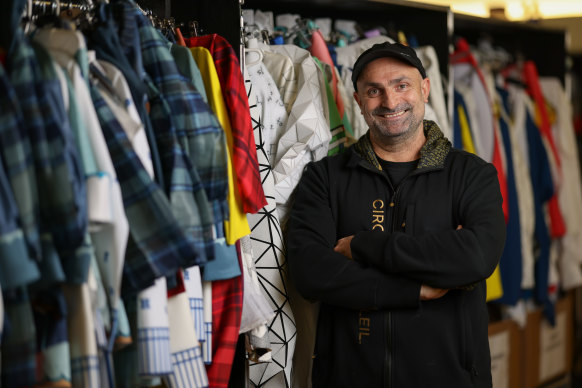
Robert Tannion, the Australian-born artistic director of Crystal, backstage in Hamburg.Credit: Hollie Adams
Tannion comes from Brisbane and started out as a dancer; his previous job was artistic director at Circus Oz. He didn’t know much about ice or skating before he arrived in Montreal in 2019, ready to take over as artistic director on Crystal. Now he knows all about the varying quality of the “house ice” spread in sports venues, how the underfloor freezing pipes work, how the frozen surface must be watered and scraped by the technicians – “they’re like gardeners” - and what to wear on ice as a tumbler. Crampons and flesh-coloured, fast-drying gloves with spikes, as it turns out, made of a material that won’t readily rot.
Cirque du Soleil is unquestionably the behemoth of the circus arts. Even after being closed for nearly two years, it remains the biggest touring entertainment company in the world. The company faced its greatest calamity during the pandemic, when, already over-stretched, it was forced to file for bankruptcy.
Show publicist Christine Achampong says that, under a new CEO seen to be more fiscally cautious, they have nine touring shows currently on the road and five shows, four of them permanent fixtures, running in Las Vegas – not as many as before the pandemic, but the evidence of rapid recovery.
Lockdown was disastrous for all the performing arts, of course, but the sheer size of Cirque du Soleil put it on a different scale of disaster. In March 2020, the company was carrying $US900 million ($1.35 billion) in debt, a legacy of the last financial tempest – a leveraged buyout, led by US equity firm TPG in 2015, of most of the founder Guy Laliberte’s shares – which had seemed manageable with an annual turnover of $US1 billion. Overnight, that turnover shrank to nothing as 71 shows went dark. Then the six Las Vegas casinos where Cirque du Soleil had residencies closed their doors. A week later, then CEO Daniel Lamarre had to lay off 95 per cent of the workforce: 4679 people. By June, the company was in bankruptcy protection.
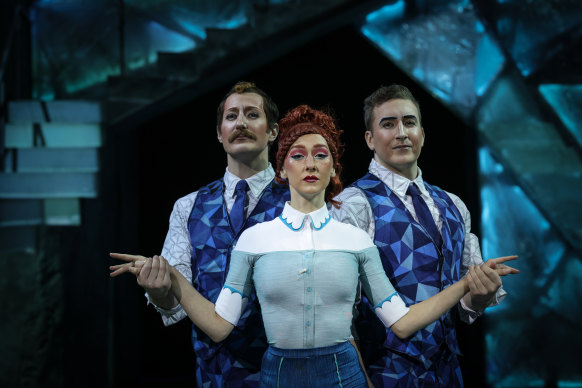
From left, Australian Nathan Boyle with British skater Emily McCarthy and fellow Australian Nick Hutchinson in Crystal.Credit: Hollie Adams
Their subsequent rescue involved a deal with creditors that left the company under the control of a Canadian private equity firm called Catalyst Capital. Many felt the company was irrevocably changed as a result. That process had accelerated with each corporate refinancing and finished only in February 2020, when Laliberte sold the very last of his stake – and was now focused as much on “market management” as creativity.
Patrick Leroux, a professor at Montreal’s Concordia University and a specialist in circus culture, told Canada’s Financial Post that while the industry needed the circus to be strong, the change in management had also changed the relationship between the company and its performers. Some realised, he said, that they didn’t want to work for a behemoth after all.
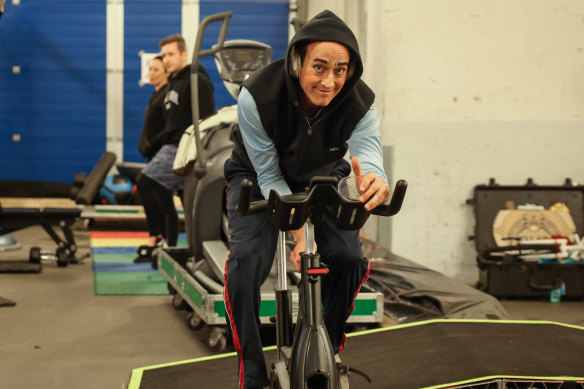
Clown Nathan Cooper works out backstage.Credit: Hollie Adams
For many companies, that wouldn’t especially rankle. But for Cirque du Soleil, which has always prided itself on retaining the family feeling and loyalties of an old-school travelling circus – an ethos that made any restructuring, especially the pandemic collapse, a real agony – it must really hurt.
Wandering backstage in Hamburg, where a cheery clown greets us from the exercise bike where he is limbering up and acrobats welcome us to their hand-to-hand practice, it certainly doesn’t feel like visiting head office at a bank. There are 113 people here – 64 artists and 49 supporting crew, with 18 languages between them. One of their off-duty pursuits, says Achampong, is teaching their languages to each other. After the last show each day, there is free skating time when everyone can come on the ice and learn from the experts.
“I think you don’t know what a company is like till you’re in it,” says Tannion. “I’d always seen it as a juggernaut, but it’s interesting to find how each show has its own nucleus and way of working, so while it is under the umbrella of Cirque, it has its own heart. And Crystal has a beautiful heart.”
Crystal, which premiered in 2017, is Cirque du Soleil’s 42nd show. Like earlier productions, it is made in the mould of older European circus, with an emphasis on poetry and performance, rather than a succession of death-defying acts in the manner of P.T. Barnum. Extreme skating from the “hockey team”, trapeze swings, pole acts and juggling are framed by the story of a young girl who feels alienated from her family, school and town. Eight skaters and acrobats play versions of Crystal, indistinguishable from each other in their schoolgirl tartan skirts and cascading russet wigs. Cirque doesn’t do stars; they do teamwork. If someone has to drop out, says Tannion, even in the middle of a show, his priority is to ensure that nobody in the audience notices.
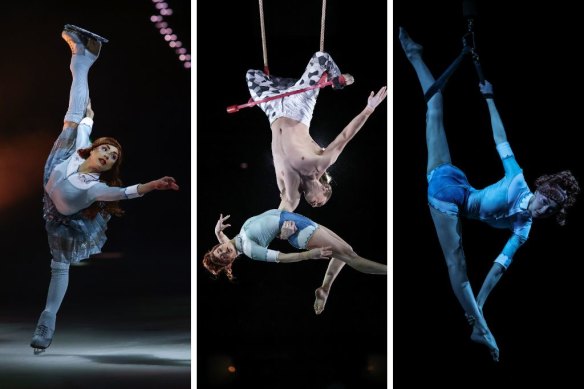
From left, Nikol Gosviiani; Harley McLeish with Amber Vvan Wijk; Emily McCarthy. Credit: Hollie Adams
Do the eight women try to match their performances? “We have talks with [the] artistic director to get an understanding,” says Nikol Gosviiani, who was a competitive skater in Russia before joining Cirque du Soleil. “But we perform together every day, so we know how to connect and be similar.” Connection is key to circus, where performers literally put their lives in each other’s hands.
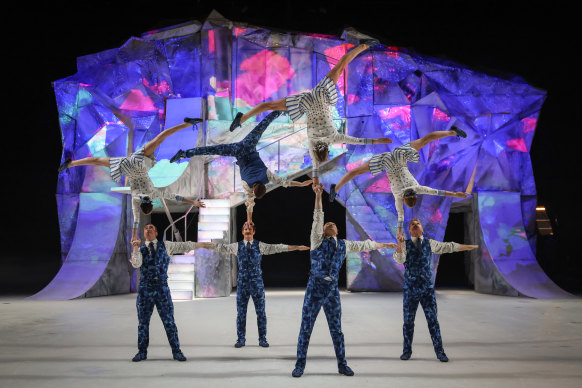
Australian performers (L-R front row) Nick Hutchinson, Nathan Boyle, Harley McLeish and Will Meager at work in Hamburg.Credit: Hollie Adams
The skaters have to mind their heads in new and scary ways. “If you get hit by one of those poles, you might not make it,” says American skater Mary Siegel, bluntly. Emily McCarthy, who competed for Britain in gymnastics before joining the circus 11 years ago – at 16, she was one of the last minors to be employed – is just as direct. “This could end for us all tonight; what we do is extremely dangerous,” she says. “At the end of my act, I drop head-first and get caught by someone else. My entire act is about trust and making sure you communicate well. Things do go wrong, so I often think about that.”
Possibly not as often, however, as she thinks about how to make the job last as long as possible. A performer’s career is relatively short, but most can’t imagine any other kind. “I love it, even though it’s hard. Two shows today; three on Saturday and Sunday,” McCarthy says. “You do get tired. Your muscles are tired. But then you want to make sure everyone who has bought a ticket has the same experience.” Her worst time was when she broke her ankle and had to spend four months in recovery. “Your body is your tool and what makes your money and suddenly you can’t do it any more. You do feel a bit hopeless. I felt lost.” Her throat catches as she remembers. “Trying to find out who I am without circus would be a bit difficult.”
Being in a circus also involves constant togetherness off-stage. You either love that life or you don’t – and it is a big jump for people who came from competitive sports, where the individual is key. Siegel, who has spent a decade doing ice shows – “more glamorous, showgirl stuff: sparkles and fishnets” – says the backstage atmosphere of Cirque is completely different from what she is used to seeing. “Circus people are so much more easy-going than figure skaters,” she says. “Figure skaters can be uptight and selfish, used to doing what they’re doing. It was eye-opening at first to see how friendly acrobats can be, that they’re not kind of two-faced, saying nice things to you and bad things behind your back.”
Four of the porters – the acrobats who catch and throw aerialists – are Australians, who banter with each other in a very Australian way; one of them, Nick Hutchinson, spent three years with the Wiggles, which comes up in conversation often enough to suggest it’s a good tease. The relationship between porter and flier is symbiotic; one can’t do anything without the other. Both are also performing, even as they throw and catch their fliers. Again, that is a change of emphasis for anyone coming from sport.
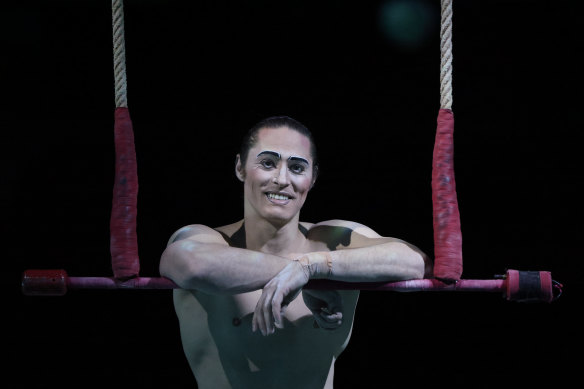
Australian Harley McLeish performs the dual roles of porter and artist coach for Cirque du Soleil’s Crystal.Credit: Hollie Adams
“It’s a lot of trust back and forth, learning to communicate,” says Harley McLeish, who started with Brisbane’s Flipside Circus when he was 10. “It can be super frustrating to try to figure out tiny little balances and these tricks. Sometimes you’re sore or tired. Sometimes it’s ‘we just don’t talk today’. It’s like having a full relationship.” They have to be comfortable together, because acrobatics involves a lot of physical intimacy; watching a porter with his face pressed against his flier’s crotch as he lowers her, I reflect that there is no room for shyness. “I feel you have to be willing to be open and vulnerable to connect with people,” says McLeish. “It’s a very hard life if you can’t do that.”
Some of those whose job it is to read the runes of Cirque du Soleil’s spectacular shows see Crystal as a reflection of the company’s steady creep towards corporatisation. The generally on-side Montreal Gazette described it as “a lot of fun” but unsatisfying. “In some ways, it may be a sign of the new Cirque, a live-entertainment company that now has newish corporate owners who are undoubtedly going to be more demanding about nabbing strong returns every quarter,” said their critic when the show opened. “Co-directors Shana Carroll and Sebastien Soldevila have been at pains to distance themselves from Disney on Ice, but clearly they’d like to scoop up some of that audience.”
Fairly obviously, one might think – and all the more now that they are clawing their way back to profit. Whether that represents any great cultural shift within the ranks or as an experience for the audience is another matter. When I finally read an English version of the script, I don’t have much more of a clue what it’s about than I did in Hamburg. But seeing a performer standing on a trapeze in skates, then leap off to whiz full-pelt across the ice, makes you gulp; seeing skaters cascade down a wall brings a collective whoop from the audience.
Naysayers may say it doesn’t have the same magic as the Cirque du Soleil of old, but it seemed to be working for the Hamburgers. Anyway, disaster has been averted. The great majority of the performers laid off in 2020 have returned to the greatest show on Earth. Once again, Cirque du Soleil is back.
Crystal is at Brisbane Entertainment Centre, July 21-30; Sydney’s Qudos Bank Arena, Aug 3-13; and Melbourne’s John Cain Arena, Aug 17-27; http://cirquedusoleil.com/crystal
Stephanie Bunbury and Hollie Adams travelled to Hamburg courtesy of Cirque du Soleil.